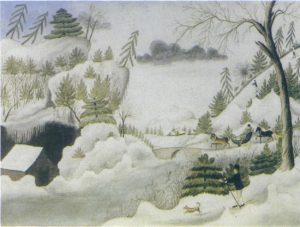A central motif in the poetry of Magdalene Sophie Buchholm (1758-1825) is, as in Christiane Koren’s Hanna, the forsaken woman. In “Den bedragne Piges Sang” (Song of the Deceived Girl) the female reader is cautioned about false declarations of love. But whereas in Hanna, it is the deceitful man who carries the blame, and the woman’s right to this man that is carried through, Buchholm’s poem is marked by accommodation and resignation. The image she portrays of women is, in other words, more clear-cut than Koren’s: she preaches a morality in which submissiveness, compliance, purity, and duty are given pride of place. “Remain always accommodating as now, / stay compliant and unassuming, / and you must never, never forget that piety is still favoured here,” we read in the poem “Til min datter” (To My Daughter). The poems might indeed intimate the suffering and injustice of this female role, but they nevertheless leave no room for indignation or protest. Buchholm’s universe has no equivalent to Koren’s Maria.
In Magdalene Buchholm’s poems, the desire for knowledge and artistic expression gives way to the woman’s obligations as wife and mother: “And if, as I, you pluck the harp / but rarely – not as celebrated poet – / then no matter how you fare, / do not forget your proper duties.” As is the case here, art can go under the guise of didactic poem, and in so doing ‘excuse’ itself.
Buchholm’s urge to write must have been strong – and conflict-ridden. She actually produced numerous poems, many of which were published in journals and poetry anthologies during the 1780s. The majority, however, were collected in her Poesier (Poetic Writings) and published in Copenhagen in 1793. The collection was issued in the author’s full name – she obviously saw no need to conceal the fact that she was a woman – and met with a very positive reception. Magdalene Buchholm’s reputation was such that she was called “Nordens Sappho” (the Sappho of the North).
In terms of content and choice of genre, Buchholm the writer was typical of her period. Her output included elegies, ballads, commemorative poems, an ode, and a héroïde, plus quite a few songs – some of which were clearly inspirered by the broadsheet ballad. However, the sensitive and elegiac poems are in the majority, often with a religious overtone.

In keeping with the Romantic idyllisation of peasant culture, Magdalene Buchholm played rural life off against the duress, noise, and falsity typical of urban existence. Naturalness is also highlighted in her morally instructive poems, but here it is seen as the greatest of womanly virtues.
Marriage to the clergyman Peter L. Castberg took Magdalene Buchholm from her Norwegian homeland to Copenhagen in the late 1770s. In the Danish capital she was admitted to Det Norske Selskab (the Norwegian Society) with the status of full member, and she was awarded the Society prize. The gentlemen were particularly impressed by her héroïde “Adeluds til Torkild Trondesøn” (Adeluds to Torkild Trondesøn), in which classical ideals were very much at the forefront.
“Adeluds til Torkild Trondesøn”, which was included in Poesier, is structured around the familiar motif of young lovers who are kept apart. Thanks to the decisions of their fathers, Adeluds and Torkild are each living in an unhappy marriage. The poem takes the form of a letter from the female party to her beloved. We read of how she misses him, of her memories, and the dream of being once more united:
O, Cupid! Hear my prayer, keener than any other,
That should fate not hold so great a joy for me,
Then fortify this hope, through which I am consoled:
O wretched me, Adeluds, should this dream perish.
In 1806 the “Andet og forøgede Oplag” (second and enlarged edition) of Poesier was published, but this time the reception was far from enthusiastic. Buchholm’s form and style had, in all probability, become outdated. With the exception of a solitary and untitled poem, published in Den Norske Rigstidende (the Norwegian National Times) in 1815, the 1806 edition marked the conclusion of Magdalene Buchholm’s writing activities.
Her success as an author was, in other words, short-lived, even though she was the only Norwegian female writer to win wide recognition in the latter half of the eighteenth century. Could it have been that the aspiration of submissiveness for which Poesier strived ultimately overtook her?
Translated by Gaye Kynoch

